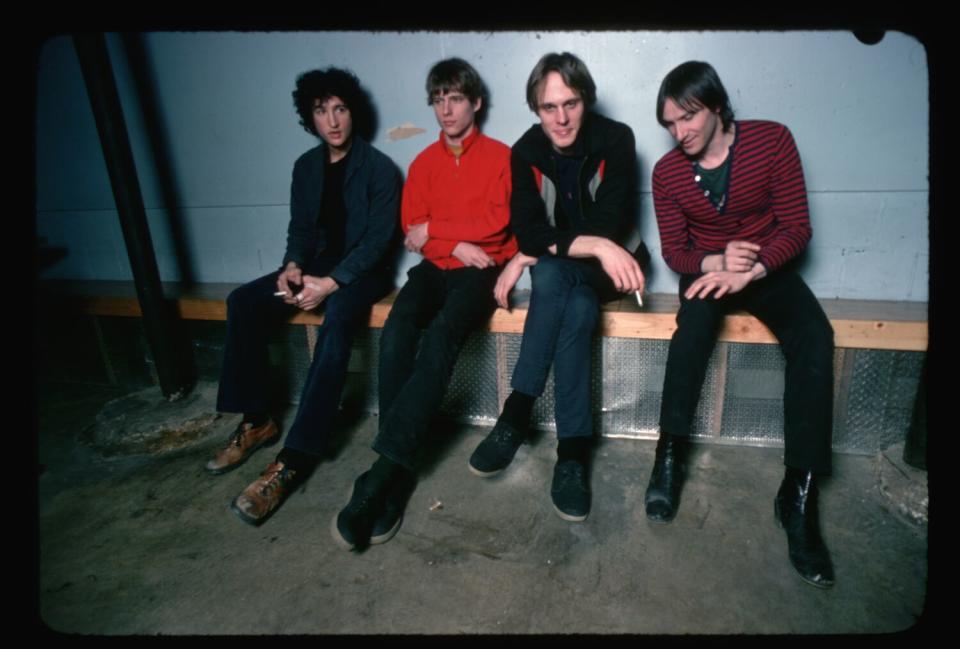Tom Verlaine, singer and guitarist for seminal art-punk band Television, dies at 73

Tom Verlaine, the singer and guitarist who fronted the singular, ambitious and oblique New York band Television, with whom he made two of rock’s most acclaimed albums, died Saturday in Manhattan. He was 73.
Verlaine’s death was confirmed to The Times by his former manager, John Telfer, who stated that it followed “a brief illness.”
Jimmy Rip, a friend who played with Verlaine for decades, wrote on Instagram, “At the end, he was surrounded by love and passed peacefully with the hands of myself and four more of his nearest and dearest friends on him.
“The personal loss, for me, is absolutely devastating. The loss, to the world, of this most innovative, imitated and iconic artist is incalculable.”
Although Television first attracted attention at the New York punk rock club CBGB, Verlaine wasn’t a fan of punk, which he described as “just amped-up bubblegum with angrier lyrics.” Among other things, punk bands eschewed solos; Verlaine and fellow guitarist Richard Lloyd did not. In 2012, Spin magazine placed Verlaine and Lloyd seventh on a list of the 100 Greatest Guitarists of All Time, likening their soloing to that of the Grateful Dead; Mojo magazine ranked Verlaine 34th on a similar list (one place ahead of Jerry Garcia), and Rolling Stone slotted him at 90.
The first two Television albums — “Marquee Moon,” released in 1977, and “Adventure,” a year later — were enough to cement the band’s legend. But the records didn’t sell, and the band broke up, reuniting for a third album, “Television,” in 1992 before disappearing again. They toured sporadically, even after Lloyd left in 2007, having grown frustrated at Verlaine’s unwillingness to record new music.
Television introduced ideas that hung around rock for decades. Subsequent generations of musicians seemed to base their styles on one song or even part of one; the bridge to the stupendous 10-minute track “Marquee Moon” anticipates much of Sonic Youth’s output, and R.E.M.’s first decade seemed to spring from the cascading arpeggios in “Days,” from “Adventure.”
Verlaine was passionate about harmonically complex music, especially jazz saxophonists John Coltrane and Albert Ayler, classical composers Henryk Gorecki and Krzysztof Penderecki and film composers Bernard Herrmann and Henry Mancini. He was also a sophisticated fan of literature, including the French Symbolists of the late 1800s, including the poet Paul Verlaine, to whom he paid tribute when inventing a pseudonym.

Thomas Miller was born Dec. 13, 1949, and grew up in Wilmington, Del. He learned piano and sax, then switched to guitar. His parents, Victor and Lillian Miller, sent him to boarding school, where he met a troublemaker named Richard Meyers. The two devised a plan to run away to Florida, and with $50 between them, they set out like teen-rebel versions of Huck Finn and Tom Sawyer, mostly hitchhiking.
The pair got as far as Alabama, where they slept rough in a field one night and started a fire to keep warm. When they began throwing burning sticks around the field, it caught fire, unsurprisingly, and they were arrested.
Verlaine finished high school and endured a year of college before moving to New York in late 1968. Meyers, who renamed himself Richard Hell, visited Verlaine, and they hung around dank New York clubs like Max’s Kansas City and the Mercer Arts Center, where they saw the New York Dolls.
“We were inseparable,” Hell said in the punk rock oral history “Please Kill Me.”
Both worked at a bookstore called Cinemabilia, managed by Terry Ork, an Andy Warhol assistant who lived in a capacious Chinatown loft. Verlaine had been playing acoustic guitar at hootenanny nights around the city, and Hell prodded him to start a rock band.
“I didn’t see anybody in New York then who was doing anything,” Verlaine said. “It was all glamour — all visuals.”
Verlaine taught Hell, a novice, to play bass, and with drummer Billy Ficca, whom Verlaine knew from Delaware, they formed a trio called the Neon Boys, which recorded two songs that weren’t released until 1980. After they broke up, Ork introduced Verlaine to Lloyd, completing the original lineup of Television.
They played their first gig at the Town House Theater in March 1974, the same year Verlaine played guitar on Patti Smith’s first single, “Hey Joe.” (He played guitar the next year on her debut album, “Horses,” as well, and the two became a couple.)
While looking for a place where they could gig regularly, Verlaine and Lloyd spotted a dive bar on the Bowery, above a flophouse unpersuasively called the Palace. The club’s name was CBGB, which stood for country, bluegrass and blues, and Verlaine and Lloyd lied to owner Hilly Kristal, claiming that was the type of music they played, in order to get a foot in the door. Soon, Smith, Talking Heads, Blondie and Ramones were playing there too. The Bowery was never the same.

 Yahoo Autos
Yahoo Autos 